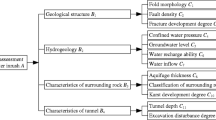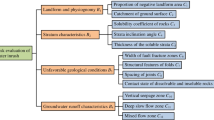Abstract
This paper presents an improved risk assessment model to evaluate the risk of water inrush in karst tunnels based on matter element theory and ideal point method. The 4 first-grade evaluation indexes and 13 s-grade factors are selected to establish the evaluation index system by considering the occurrence conditions of water inrush. All second-grade evaluation indexes are quantitatively divided into four risk grades. Based on improved Analytical Hierarchy Process and Triangular Fuzzy Number, the constant weights are obtained. The variable weights are determined according to the state variable weight theory and the values of evaluation indexes. The risk grade of water inrush is recognized by the closeness degree analysis. The proposed risk assessment model was applied to 3# inclined shaft of Yuelongmen tunnel, and the accuracy of the assessment result was verified by comparing with advance geological forecast and excavation. This proposed model provides a practical tool to evaluate the risk of water inrush in karst tunnels.






Similar content being viewed by others
References
Beaudequin D, Harden F, Roiko A, Mengersen K (2017) Potential of Bayesian networks for adaptive management in water recycling. Environ Modell Softw 91:251–270
Bu L, Li SC, Shi SS, Zhao Y, Zhou ZQ, Nie LC, Sun HF (2019) Application of the comprehensive forecast system for water-bearing structures in a karst tunnel: a case study. Bull Eng Geol Environ 78:357–373
Bukowski P (2011) Water hazard assessment in active shafts in upper silesian coal basin mines. Mine Water Environ 30(4):302–311
Chu HD, Xu GL, Noriyuki Y, Zhang Y, Liu P, Wang JF (2017) Risk assessment of water inrush in karst tunnels based on two-class fuzzy comprehensive evaluation method. Arab J Geosci 10:179
Hu JH, Jing JM, Deng YL, Gao C (2018) Comprehensive assessment on water inrush hazard of railway tunnel based on AHP-cloud model. Sci Technol Dev 14(04):311–317
Huang XJ (2013) Influence factors of water bursting and mud bursting of karst tunnels and its countermeasures. J Rail Eng Soc 30(01):45–48
Huang X, Lin P, Xu ZH, Li SC, Pan DD, Gao B, Li ZF (2018) Prevention structure assessment method against water and mud inrush in karst tunnels and its application. J Cent South Univ (Sci Technol) 49(10):2533–2544
Khademi Hamidi J, Shahriar K, Rezai B, Rostami J, Bejari H (2010) Risk assessment based selection of rock TBM for adverse geological conditions using Fuzzy-AHP. Bull Eng Geol Environ 69(4):523–532
Li HX (2004) Fuzzy decision making based on variable weights. Math Comput Model 39(2–3):163–179
Li LP, Lei T, Li SC, Xu ZH, Xue YG, Shi SS (2015) Dynamic risk assessment of water inrush in tunnelling and software development. Geomech Eng 9(1):57–81
Li SC, Zhou ZQ, Li LP, Lin P, Xu ZH, Shi SS (2016) A new quantitative method for risk assessment of geological disasters in underground engineering: attribute interval evaluation theory (AIET). Tunn Undergr Space Technol 53:128–139
Li LP, Sun SQ, Wang J, Yang WM, Song SG, Fang ZD (2020a) Experimental study of the precursor information of the water inrush in shield tunnels due to the proximity of a water-filled cave. Int J Rock Mech Min Sci 130:104320
Li LP, Sun SQ, Wang J, Song SG, Fang ZD, Zhang MG (2020b) Development of compound EPB shield model test system for studying the water inrushes in karst regions. Tunn Undergr Space Technol 101:103404
Li SC, Wang K, Li LP, Zhou ZQ, Shi SS, Liu S (2017) Mechanical mechanism and development trend of water-inrush disasters in karst tunnels. Chin J Theor Appl Mech 49(01):22–30
Li SC, Xu ZH, Huang X, Lin P, Zhao XC, Zhang QS, Yang L, Zhang X, Sun HF, Pan DD (2018) Classification, geological identification, hazard mode and typical case studies of hazard-causing structures for water and mud inrush in tunnels. Chin J Rock Mech Eng 37(05):1041–1069
Li SC, Zhou ZQ, Li LP, Xu ZH, Zhang QQ, Shi SS (2013) Risk assessment of water inrush in karst tunnels based on attribute synthetic evaluation system. Tunn Undergr Space Technol 38:50–58
Li ZY, Wang YC, Liu Y, Jiao QL, Wang MT, Zhang Y (2019) Model on variable weight−target approaching for risk assessment of water and mud inrush in intrusive contact tunnels. J Cent South Univ (Sci Technol) 50(11):2773–2782
Lin CJ, Zhang M, Zhou ZQ, Li LP, Shi SS, Chen YX, Dai WJ (2020) A new quantitative method for risk assessment of water inrush in karst tunnels based on variable weight function and improved cloud model. Tunn Undergr Space Technol 95:103136
Lu Z, Wu L, Zhuang X, Rabczuk, (2016) Quantitative assessment of engineering geological suitability for multilayer urban underground space. Tunn Undergr Space Technol 59:65–76
Morsali M, Nakhaei M, Rezaei M, Hassanpour J, Nassery H (2017) A new approach to water head estimation based on water inflow into the tunnel (case study: Karaj water conveyance tunnel). Q J Eng Geol Hydrog 50(2):126–132
Nezarat H, Sereshki F, Ataei M (2015) Ranking of geological risks in mechanized tunnelling by using fuzzy analytical hierarchy process (FAHP). Tunn Undergr Space Technol 31(50):358–364
Tu W, Li L, Shang C, Liu S, Zhu Y (2019) Comprehensive risk assessment and engineering application of mine water inrush based on normal cloud model and local variable weight. Energy Source Part A. https://doi.org/10.1080/15567036.2019.1696427
Wang YC, Jing HW, Yu LY, Su HJ, Luo N (2016) Set pair analysis for risk assessment of water inrush in karst tunnels. Bull Eng Geol Environ 76(3):1199–1207
Wang S, Wen T, Ying S, Cai F, Pang B (2017) Application of attribute model with varying weights in risk identification of high and steep slope in three gorges reservoir area and engineering application. Ecology Environ Monit Three Gorges 2(4):59–65
Wang J, Li SC, Li LP, Lin P, Xu ZH, Gao CL (2019a) Attribute recognition model for risk assessment of water inrush. Bull Eng Geol Environ 78(2):1057–1071
Wang XT, Li SC, Xu ZH, Hu J, Pan DD, Xue YG (2019b) Risk assessment of water inrush in karst tunnels excavation based on normal cloud model. Bull Eng Geol Environ 78:3783–3798
Wang S, Li SC, Li LP, Shi SS, Zhou ZQ, Cheng S, Hu HJ (2019c) Study on early warning method for water inrush in tunnel based on fine risk evaluation and hierarchical advance forecast. Geosci 9(9):392
Wang S, Li LP, Cheng S, Hu HJ, Zhang MG, Wen T (2020) Risk assessment of water inrush in tunnels based on attribute interval recognition theory. J Cent South Univ 27(02):517–530
Wu Q, Li B (2016) Determination of variable weight interval and adjust weight parameters in the variable weight assessment model of water inrush from coal floor. J China Coal Soc 41(9):2143–2149
Yuan YC, Li SS, Zhang QQ, Li LP, Shi SS, Zhou ZQ (2016) Risk assessment of water inrush in karst tunnels based on a modified grey evaluation model: Sample as Shangjiawan Tunnel. Geomech Eng 11:493–513
Zhang K, Tannantb DD, Zheng WB, Chen SG, Tan XR (2018) Prediction of karst for tunnelling using fuzzy assessment combined with geological investigations. Tunn Undergr Space Technol 80:64–77
Zhang K, Zheng WB, Xu C, Chen SG (2019) An improved extension system for assessing risk of water inrush in tunnels in carbonate karst terrain. KSCE J Civ Eng 23(5):2049–2064
Zhu JQ, Li TZ (2020) Catastrophe theory-based risk evaluation model for water and mud inrush and its application in karst tunnels. J Cent South Univ 27:1587–1598
Acknowledgements
This work was supported by National Science Foundation for Distinguished Young Scholars of China (Grant No.52025091), Joint Funds of the National Natural Science Foundation of China (Grant No.U1934218), Shandong Provincial Key Research and Development Program (Major Scientific and Technological Innovation Project) (NO.2019JZZY010428; NO.2019JZZY010428), National Natural Science Foundation of China (51808359), Hebei Provincial Natural Science Foundation of China (E2019210356), Natural Science Foundation of Chongqing (cstc2019jcyj-msxmX0813), Youth Science and Technology Innovation Project from Gansu Academy of Sciences(2019QN-04).
Author information
Authors and Affiliations
Corresponding author
Additional information
Publisher's Note
Springer Nature remains neutral with regard to jurisdictional claims in published maps and institutional affiliations.
Rights and permissions
About this article
Cite this article
Wang, S., Li, L., Cheng, S. et al. Model on Improved Variable Weight-Matter Element Theory for Risk Assessment of Water Inrush in Karst Tunnels. Geotech Geol Eng 39, 3533–3548 (2021). https://doi.org/10.1007/s10706-021-01709-y
Received:
Accepted:
Published:
Issue Date:
DOI: https://doi.org/10.1007/s10706-021-01709-y




